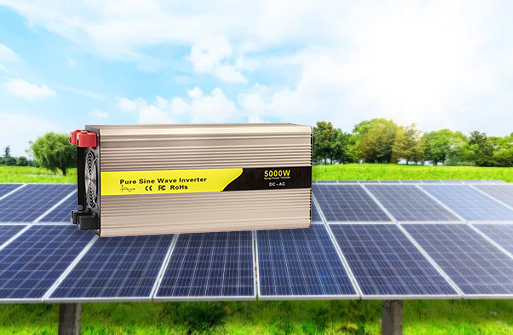The output power of solar photovoltaic system is generally difficult to reach the nominal power of the module, because the power of the module is tested under very good weather conditions and the temperature of the module is relatively low. Normal weather is not able to achieve this condition, photovoltaic modules may not all receive solar energy, because the photovoltaic system has losses.
Such as dust, block, shadow on the components, cables, switches, joints and other line losses; Inverter, transformer, distribution cabinet and other equipment loss. In general large power stations, the maximum output power of the system may only be about 85%-90% of the rated power of the components. In a small distributed power station, the maximum system output may only be about 90% to 95% of the rated power of the components. In this article, Home Power Inverter will tell you more. We list two factors:

Solar Irradiance Factor:
We often say that the 340W photovoltaic module, the maximum power Pmax/W, represents the peak power of 340W in the standard test environment. Only under standard test conditions (irradiance 1000 W/m2, cell temperature 25 ℃), the output power of the photovoltaic module is "nominal power" (340W), and the power will also change when the irradiance and temperature change.
System Loss Factor:
The key factor affecting power generation is system efficiency, and the main factors to be considered in system efficiency are as follows: Dust on the component, shadow block caused by the efficiency of the reduction, the component temperature caused by the reduction of power, impedance matching loss caused by DC cable, component series voltage and power inverter voltage mismatch caused by the efficiency of the reduction, the inverter MPPT tracking loss, the inverter itself power loss, AC cable power loss, transformer power loss and many other factors.
| Content | Percentage |
| Module dust, shadow, temperature | 1.5-3.0% |
| DC cable, connector internal resistance loss | 1.0-1.5% |
| Impedance matching of DC cable | 1.5-3.0% |
| Module and inverter voltage match | 0.5-1.0% |
| Inverter MPPT tracking efficiency | 0.5-1.0% |
| Inverter efficiency | 1.0-1.5% |
System loss is the loss of comprehensive power generation, and the value varies according to the conditions. The factors that affect the maximum power output are components and DC cables. To increase the output power, various losses must be minimized. After the photovoltaic installation location is determined, it is difficult to change the installation angle, component temperature, inverter loss, MPPT tracking efficiency and other factors. However, factors such as DC cable loss, DC cable impedance matching, and component and sine wave inverter voltage matching can be controlled.
- As far as possible to reduce the length of DC cable, from the component to the inverter, to use DC cable, the length of the cable has a very large impact on the system power generation, on the one hand is the loss of DC cable itself, on the other hand is impedance matching, inverter as close as possible to the component, DC cable control within 20 meters, each DC cable of MPPT as consistent as possible.
- The working voltage of the components after series is as close to the rated voltage of the inverter as possible to reduce the loss of the inverter.
How to Judge Whether the Photovoltaic System is Normal?
The first is to check the output power of the solar power inverter. In particularly good weather, if more than 90% of the power of the components can be achieved, there is nothing wrong with the design of the system. Secondly, simply calculate the electricity generation, check the local average daily energy generation hours, multiply the number of hours by 365, and then multiply the system efficiency to get the average annual energy generation. Generally, the system efficiency is 0.8. For example, the average daily energy generation hours is 3.5, and a 40 kW electricity, the average annual energy generation is 40*3.5*365*0.8=40880 degrees. If it is within this range, the system is well designed and installed.
